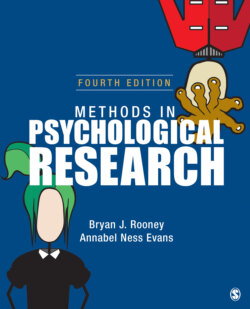Читать книгу Methods in Psychological Research - Annabel Ness Evans - Страница 87
На сайте Литреса книга снята с продажи.
F Test.
ОглавлениеThe F test of significance is used to compare means of more than two groups. There are numerous experimental (and quasi-experimental) designs, known as ANOVAs, that are analyzed with the F test. Indeed, when we were graduate students, we took entire courses in ANOVA. In general, the F test, like the t test, compares between-group variability with within-group variability.
As with the t test, the researcher will report the group means and whether the differences were statistically significant. From a significant F test, the researcher knows that at least two means were significantly different. To specify which groups were different from which others, the researcher must follow the F test with post hoc (after the fact) comparisons. For example, if there were three groups and the F test was statistically significant, a post hoc test might find that all three group means were statistically significantly different or perhaps that only one mean differed from the other two. There are a large number of post hoc tests (e.g., Scheffé, Tukey’s least significant difference, and Bonferroni) that have slightly different applications. What is common to all these tests is that each produces a p value that is used to indicate which means differ from which.
As indicated above, many designs are analyzed with an F test, and they have names that indicate the number of IVs. You will find a one-way ANOVA used when there is one IV, a two-way ANOVA when there are two IVs, and a three-way ANOVA (you guessed it) when there are three. A null hypothesis is tested for each IV by calculating an F statistic. The advantage of the two- and three-way ANOVAs is that an interaction effect can also be tested. An interaction occurs when different combinations of the levels of the IVs have different effects on the DV. For example, if we wanted to investigate the effect of environmental noise (silent vs. noisy) on reading comprehension and the effect of different-colored paper (white, yellow, and pink) on reading comprehension, we could use a two-way ANOVA to evaluate the effect of each IV and also whether the color of paper might interact with the noise to influence reading comprehension. It may be that noise produces a reduction in reading comprehension for white paper but not for yellow or pink paper. The interaction effect is important because it indicates that a variable is acting as a moderating variable. In this example, the effect of environmental noise on reading comprehension is moderated by the color of the paper.
There is another type of ANOVA that is used to control for a possible confounding variable. This procedure also uses the F statistic and is called analysis of covariance, or ANCOVA. Using our paper color example, suppose we want to test whether the color of paper will influence reading comprehension, but our participants vary considerably in age. This could pose a serious confound because reading comprehension changes with age. If we measured age, we can use ANCOVA to remove variability in reading comprehension that is due to age and then test the effect of color. The procedure removes the variance due to age from the DV before the F is calculated for the effect of color. Consequently, we are testing the effect of color after we have taken into account the effect of age.
The statistics described here are useful for comparing group means, but you may come across research where the variables are categories and the data are summarized by counting the frequency of things. When there are frequency counts instead of scores, you may see a chi-square test.
